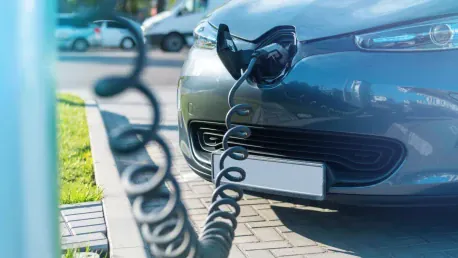Electric vehicles (EVs) are significantly transforming network drive testing operations within the telecommunications sector. As sustainability goals intensify and environmental regulations become more stringent, telecom companies are finding themselves under pressure to reduce their carbon footprints while maintaining operational efficiency. The integration of EVs into network testing is emerging as a strategic solution addressing both environmental and business imperatives. EVs don’t just support greener initiatives but also push for more efficient, flexible, and innovative testing processes.
Driving Innovation in Network Testing
EVs as Mobile Power Stations
The adoption of EVs is creating new possibilities for network testing, particularly through technologies like Vehicle-to-Load (V2L). By enabling electric vehicles to power testing equipment directly, V2L technology eliminates the need for auxiliary power sources, thus streamlining the testing process. High-power V2L systems in EVs such as the Ford F-150 Lightning and Hyundai IONIQ 5 enhance their role as mobile power stations, supporting comprehensive test setups without compromising efficiency. These vehicles, equipped with significant power outputs, can support multiple scanners, computers, and even climate control systems amidst testing operations.
With the ability to function as mobile power stations, EVs transform traditional drive testing equipment setups, making them more adaptable and versatile. This innovation particularly benefits network testing in areas lacking conventional power sources, enabling telecom companies to continue their operations seamlessly. Not only do these EVs cut down emissions, but they also eliminate the logistical challenges associated with traditional power arrangements. Essentially, the V2L capability embedded in modern EVs is not just a technological novelty but a game-changer for how telecom companies plan and execute their network testing protocols in diverse conditions.
Enhancing Operational Efficiency
With built-in power capacities, EVs enable more seamless and flexible testing operations. This technological innovation allows telecoms to extend their testing capabilities, ensuring they can conduct thorough network evaluations even in remote areas without access to conventional power sources, thus significantly enhancing operational efficiency. Since many EVs now feature sophisticated onboard systems that help manage energy consumption more effectively, telecom firms are assured of extended operational timelines and reduced interruptions due to refueling or power issues.
EVs with V2L technology can drastically reduce downtime, thereby fostering more efficient and productive testing schedules. This is especially vital in rural and less accessible regions where power infrastructure might be deficient. EVs’ built-in efficiency and adaptability eliminate the need for extensive preparation or additional support systems, allowing telecom companies to allocate their resources more strategically. The convergence of these aspects positions EV technology as the backbone of future network drive testing initiatives, reiterated by major operators worldwide who are gradually shifting their fleets towards electric mobility.
Impact on Network Usage Patterns
Charging Stations as Network Hotspots
As electric vehicles become more widespread, the pattern of network usage is undeniably shifting, with charging stations emerging as the new epicenters of data activity. Users often engage in data-intensive activities like video streaming, video calls, and web browsing during their vehicle’s recharge period, turning these stations into critical points for network performance validation and optimization. This evolving behavior compels telecom providers to consider these high-demand spots when planning and validating their network capacity, thereby enhancing overall user experience.
Charging stations, usually underestimated in the past, are now central to understanding real-world data usage patterns. They offer telecom companies a unique opportunity to gather valuable insights on network performance during peak usage times. This information helps tailor network coverage more effectively, ensuring seamless connectivity for users converging around these new hotspots. By focusing on these critical points, telecom firms can pinpoint weaknesses and optimize their services to cater specifically to high-demand scenarios typically observed at EV charging stations, thus transforming the network planning landscape.
Adapting Network Planning
The integration of electric vehicles into the consumer and corporate domains has compelled telecom companies to revise their network planning strategies. Identifying high-demand locations, such as charging stations, as crucial points for network capacity testing has become imperative to maintain optimal network performance. This adaptation involves comprehensive studies and analysis of user behavior at these sites, allowing telecom firms to better predict and manage the surge in network usage. Consequently, this data-led approach ensures that the network remains robust and responsive during high-traffic scenarios like EV recharging times.
To successfully incorporate these new findings, telecom firms must refine their network optimization techniques, synchronizing them with user patterns observed at charging stations. This new route in network planning emphasizes real-world application scenarios, pushing for an agile and dynamic operational model that continuously adapts to evolving user needs. By aligning their network structures with user-centric data emerging from EV interactions, telecom operators can significantly enhance the quality of their service, ensuring consistent and reliable connectivity tailored for the increasingly electric future.
Emerging Testing Scenarios with EVs
Urban Low Emission Zones
The rise of urban low-emission zones (LEZ) is driving the necessity for using electric vehicles in network testing. These areas, governed by stringent emission regulations, require vehicles operating within their limits. EVs align perfectly with these demands, allowing for extended testing durations without regulatory restrictions. This regulatory environment encourages telecom companies to adopt greener alternatives, facilitating uninterrupted network testing operations. Moreover, the quiet operation of electric vehicles also proves advantageous in urban settings, reducing noise pollution and aligning with urban environmental norms.
Urban LEZ not only foster sustainable network testing but also present unique opportunities for telecom companies to innovate in their testing methodologies. This adaptation ensures compliance and promotes operational excellence, marking a pivotal shift toward environmentally friendly business practices. By leveraging the advantages offered by EVs within these zones, telecom operators can conduct meticulous network tests without facing access limitations or interruptions caused by emission restrictions. This scenario highlights the symbiosis between environmental mandates and technological advancements, driving forward a cleaner, more efficient approach to network drive testing.
Rural and Remote Testing
Modern electric vehicles, boasting ranges up to 400 km, offer the capability to perform extensive testing in rural and remote areas heretofore deemed challenging due to power constraints. Their efficient power management systems and zero-emission footprints make them ideal for operations far from urban centers, providing continuous testing capabilities without environmental impact. The ability to venture into these underserved areas allows telecom companies to map network performance even at the fringes, ensuring comprehensive coverage and reliability.
Telecom firms benefit from the extended range and reliability of modern EVs, enabling thorough and uninterrupted network assessments in rural terrains. The inclusion of EVs in rural testing scenarios drastically reduces logistical hurdles and broadens the spectrum of viable testing sites. As remote regions increasingly draw digital services, verifying and improving network reliability in these locales becomes crucial. By employing EVs, telecom companies can methodically address coverage gaps, pushing the envelope of rural network infrastructure development.
The Synergy of EV Technology and 5G Networks
Automation and Route Planning
The integration of electric vehicle technology with evolving 5G networks is driving innovation in testing methodologies, particularly in route planning and automation. Advanced EV features, when paired with 5G capabilities, facilitate more precise and efficient testing processes, balancing the range of EVs with the coverage needs of telecom networks. This seamless integration fosters a holistic approach to network testing, utilizing the best aspects of both EV and 5G technologies.
Enhanced automation features supported by 5G networks allow for more accurate and efficient route planning, reducing manual intervention and error margins. This strategic confluence ensures comprehensive network coverage assessments, embracing the dynamic capabilities of 5G while leveraging the robustness and efficiency of modern EVs. By refining testing routes and methodologies through this integrated approach, telecom operators can achieve greater precision and reliability in their evaluations, ultimately enhancing the quality and consistency of network performance.
Future Network Testing Practices
Looking forward, the continued advancement of electric vehicle technology in tandem with 5G networks is expected to revolutionize network testing methodologies further. This synergy will not only enhance the efficiency and sustainability of testing operations but also contribute to the overall improvement of network performance and reliability. As both EV and 5G technologies evolve, they offer unprecedented opportunities for telecom companies to innovate in their testing practices, adopting more flexible and adaptive methodologies.
The evolving synergy between EV developments and 5G progression paves the way for a future where network testing is more intuitive, precise, and environmentally responsible. Telecom operators who embrace this convergence are likely to achieve significant operational advantages, ensuring their networks remain at the forefront of technological advancements. The integration of these advanced technologies highlights a forward-thinking approach, emphasizing constant innovation and adaptation in network testing practices to meet and exceed the ever-growing demands of a connected world.
Conclusion
Electric vehicles (EVs) are dramatically changing network drive testing operations in the telecommunications industry. With growing sustainability goals and increasing environmental regulations, telecom companies are under significant pressure to decrease their carbon footprints while maintaining high levels of operational efficiency. The adoption of EVs for network testing is proving to be a strategic move that addresses both environmental and business needs. EVs not only support green initiatives by reducing emissions but also promote more efficient, flexible, and innovative testing processes. As these companies increasingly adopt EVs, they gain an advantage by reducing operational costs and demonstrating their commitment to sustainability, which can also appeal to environmentally conscious consumers and stakeholders. Ultimately, the shift towards EVs in network drive testing is a win-win, aligning with global trends towards sustainability and enhancing the efficiency of telecom operations.









